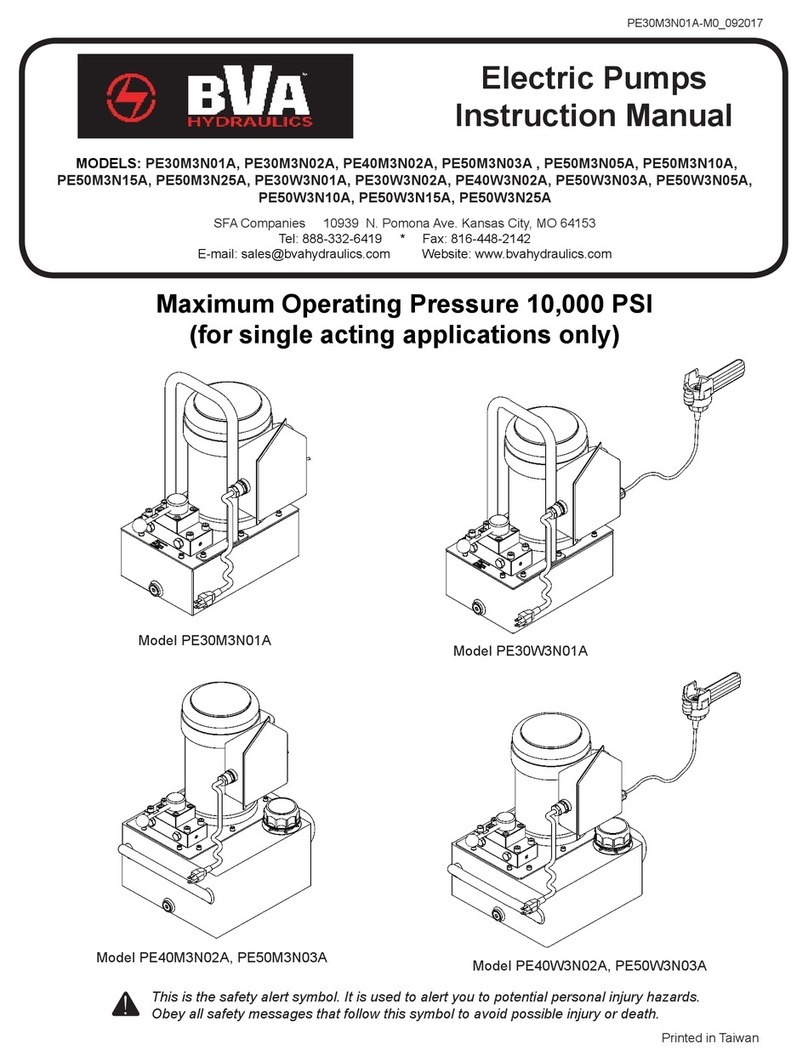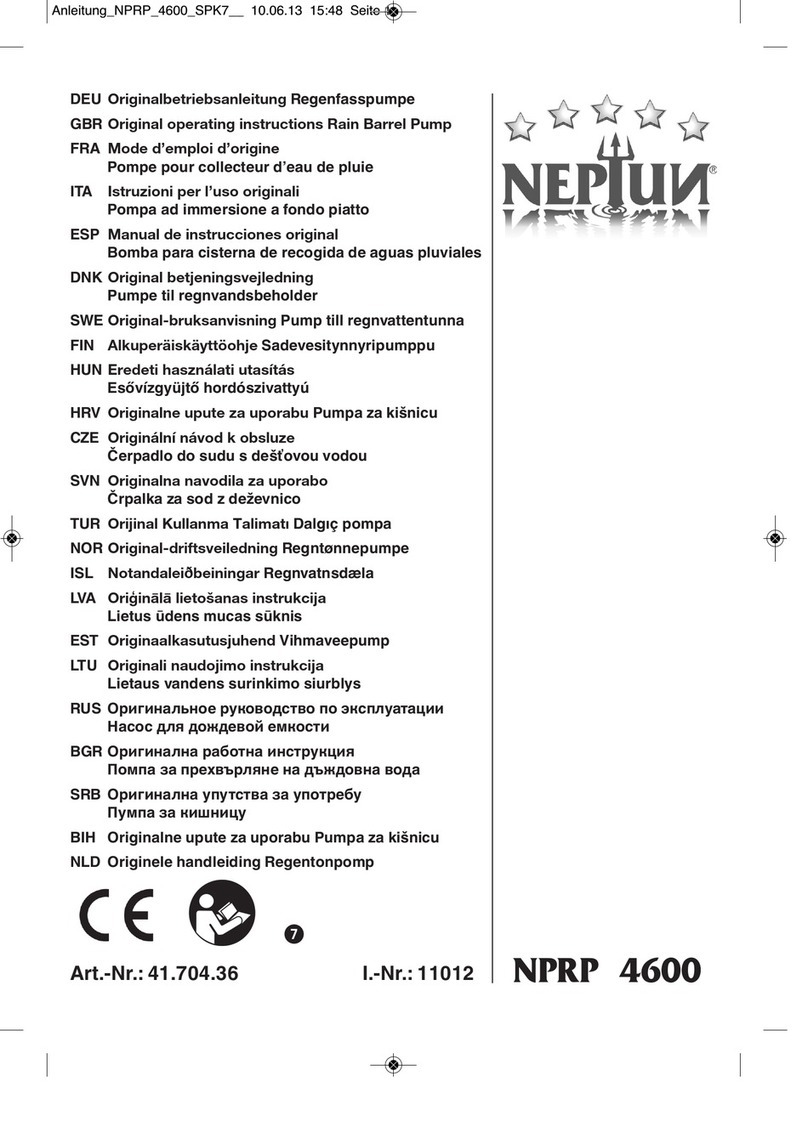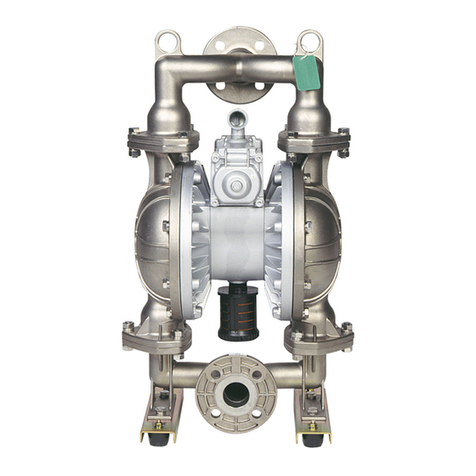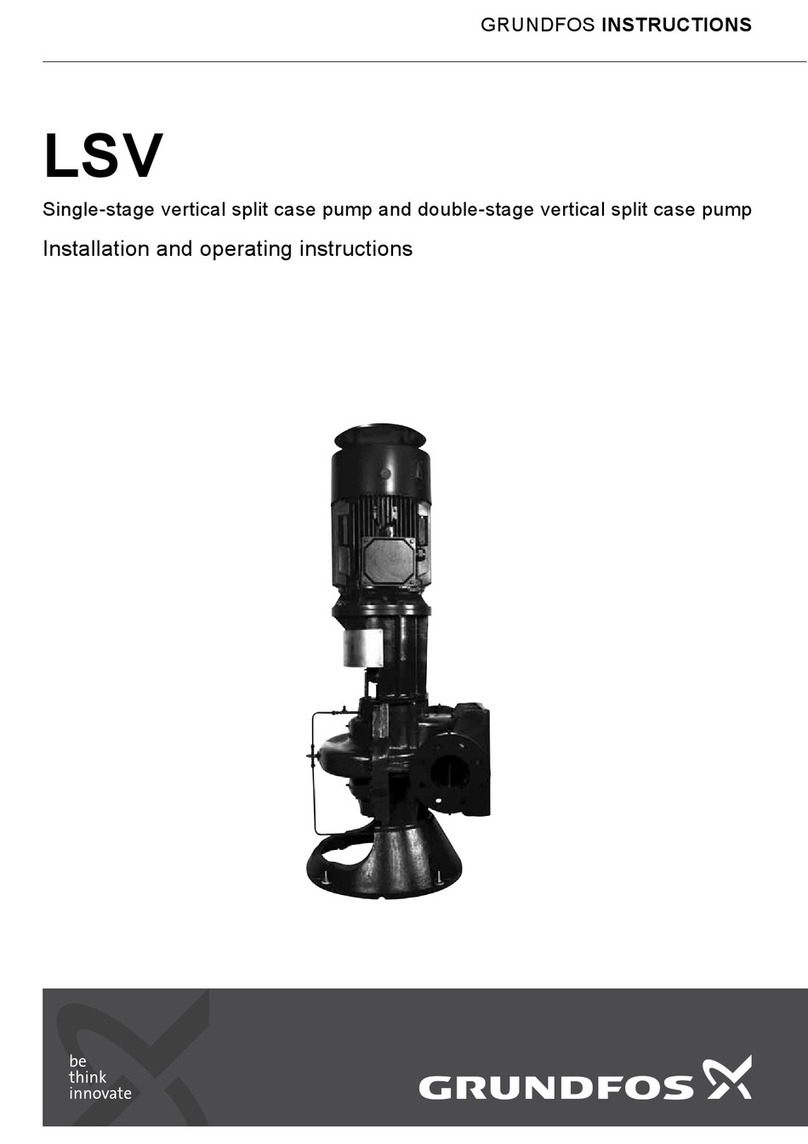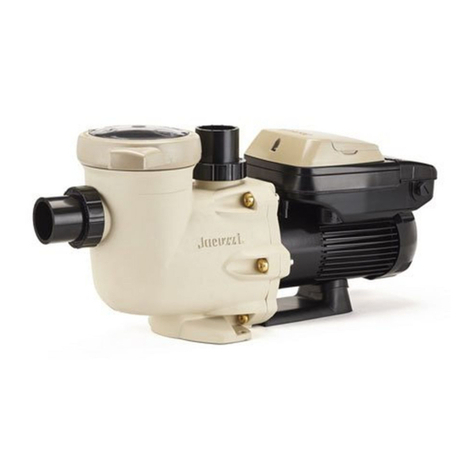Forbes Marshall FMPP30 Manual

Pressure Pump with Insulation Jacket
FMPP30
Installation and Maintenance Manual
Energy Conservation | Environment | Process Efficiency www.forbesmarshall.com

1. Preface .................................................................................1
2. Important Safety Notes ........................................................1
3. Brief Product Information ....................................................3
4. Product Working Principle.....................................................10
5. Installation Guidelines .........................................................12
6. Startup and Commissioning ................................................14
7. Maintenance Guidelines .....................................................16
8. Troubleshooting ..................................................................19
9. Available Spares ................................................................21
10. Warranty Period ..................................................................21
Table of Contents
PLEASE NOTE - Throughout this manual this cautionary symbol is used to
describe a potential damage or injury that might occur if the safety
considerations are overlooked. This symbol denotes CAUTION, WARNING or
DANGER.
Pressure Powered Pump Package Unit with IJ and CRM485R

1
1.
2.
Preface:
This manual is intended for anyone using, commissioning, servicing, or disposing the below
mentionedproductssafelyandefficiently.
PressurePumpInsulationJacket ,[FMPP30
Size: DN40 (1 ½”), DN50 (2”), DN80 (3”)
Importantsafetynotes:
Read this section carefully before installing/operating/maintaining the product. The
precautions listed in this manual are provided for personnel and equipment safety.
Furthermore, Forbes Marshall accepts no responsibility for accidents or damage
occurring as a result of failure to observe these precautions. Note that the product is
designedtoperformfornon-contaminatedfluidsonly.Acontaminationintheformof
chemical, foreign particle etc. can lead to problem with product performance and life
oftheproduct.
If these products in compliance with the operating instructions are, properly installed,
commissioned, maintained and installed by qualified personnel (refer Section 2.8) the safety
operationsoftheseproductscanbeguaranteed.Generalinstructionsfor proper use of toolsand
safetyofequipments,pipelineandplantconstructionmustalsobecompliedwith.
2.1 Intendeduse:
Check if the product is suitable for intended use/ application by referring to the installation
andmaintenanceinstructions,nameplatesandtechnicalinformationsheets
1. Theproduct issuitablefor useasdefinedinthetechnicalinformationsheet.Incasethe
need arises to use the product on any other fluid please contact Forbes Marshall for
assistance.
2. Checkforthesuitabilityinconformancetothelimitingconditionsspecifiedintechnical
informationsheetoftheproduct.
3. Thecorrectinstallationanddirectionoffluidflowhastobedetermined.
4. Forbes Marshall products are not intended to resist external stresses, hence necessary
precautionstobetakentominimizethesame.
2.2 AccessibilityandLighting:
Safeaccessibilityandworkingconditionsaretobeensuredpriortoworkingontheproduct.
2.3 Hazardousliquidsorgasesinthepipeline:
Contemplate what may have been in the pipe or is in the pipe and also for flammable
materials,substanceshazardoustohealth,extremesoftemperature.
PPPPU

2
2.4 Hazardousenvironmentandmedia:
The product has to be protected from hazardous environment and check to ensure that no
hazardousliquidsorgasespassthroughtheproduct.
2.5 Depressurizingofsystemsandnormalizingoftemperature:
Ensure isolation and safety venting of any pressure to the atmospheric pressure. Even if the
pressure gauge indicates zero, do not make an assumption that the system has been
depressurized.
Toavoiddangerofburnsallowtemperaturetonormalizeafterisolation.
2.6 Toolsandconsumables:
Ensure you have appropriate tools and / or consumables available before starting the work.
UseoforiginalForbesMarshallreplacementpartsisrecommended.
2.7 Protectiveclothing:
Consider for the requirement of any protective clothing for you/ or others in the vicinity for
protection against hazards of temperature (high or low), chemicals, radiation, dangers to
eyesandface,noiseandfallingobjects.
2.8 Permitstowork:
All work to be carried out under supervision of a competent person. Training should be
imparted to operating personnel on correct usage of product as per Installation and
Maintenance instruction. “Permit to work” to be complied with (wherever applicable), in
case of absence of this system a responsible person should have complete information and
knowledgeonwhatworkisgoingonandwhererequired,arrangetohaveanassistantwith
his primary goal and responsibility being safety. “Warning Notices” should be posted
wherevernecessary.
2.9 Handling:
There is a risk of injury if heavy products are handled manually. Analyze the risk and use
appropriatehandling method by takingintoconsiderationthetask,individual,the working
environmentandtheload.
2.10 Freezing:
Provision should be made to protect systems which are not self-draining, against frost
damage(inenvironmentwheretheymaybeexposedtotemperaturesbelowfreezingpoint)
tobemade.
2.11 Returningproducts:
CustomersandStockistareremindedthat,whenreturningproductstoForbesMarshallthey
must provide information on any hazards and the precautions to be taken due to
contamination residues or mechanical damage which may present a health, safety or
environmentalrisk.
This information must be provided in writing including Health and Safety data sheets
relatingtoanysubstancesidentifiedashazardousorpotentiallyhazardous.
Pressure Powered Pump Package Unit with IJ and CRM485R

3
3. BriefProductInformation:
PPPPU
3.1 Description:
The Forbes Marshall Pressure Powered Pump Package Unit, PPPPU, is a positive
displacement pump unit operated by steam, compressed air or pressurized gas designed
to pump hot condensate.
3.2 Sizes and Pipe Connections:
SIZE : DN40, 50 and 80 pressure powered pump package unit.
Condensate inlet : vent flanged to class 150
Condensate outlet : use flange provided with pump
3.3 Limiting Conditions:
Note: For lower operating temperatures consult Forbes Marshall
Size Condensate Pump Vent Empty
(DN) inlet conn. (A) (DN) (DN) conn. weight
40 50 50 100 245kg
50 50 80 100 350kg
80 80 80 100 395kg
outlet
conn. (B) (DN)
PMA Maximum design pressure 8.7 bar g
TMA Maximum design temperature 220°C
Operating inlet motive pressure Steam / Compressed Air /
Pressurised gas 3 - 8.7 bar g (max)
Pump discharge per cycle 30 kg
Steam consumption 3 Kg of steam per
1000 Kg liquid pumped
Air consumption 22 SCF per 1000 Kg
liquid pumped
Minimum operating temperature 0°C
Figure 1 : Pressure Powered Pump Package Unit

4Pressure Powered Pump Package Unit with IJ and CRM485R
3.5 Standard Accessories:
Condensate recovery meter - 485 (CRM485R)
and insulation jacket
3.4 Operating Range:
Figure 2 : Detail of Pressure Powered Pump Package Unit with IJ and CRM485R
35
24
29
6
4
25
305

5
PPPPU
35
24
29
6
4
25
(305)
37
38

6Pressure Powered Pump Package Unit with IJ and CRM485R
3.6 How to Select and Size:
Select the pump size according to the capacity requirement of the application from the
inlet, back pressure and filling head conditions given in the table below.
Back pressure (h) = [H X 0.1 bar g] + FP bar g + LP bar g
where H=height to which condensate is to be lifted in mtrs.
FP= Frictional pressure drop of discharge
LP=Line Pressure
22
1
2318
17
21
20
16
15
19
14
13
12
2
3
6
7
4
5
11
10
9(b)
9(a)
1
8

7
PPPPU
3.7 Capacity kg/hr.:
When installed with recommended filling head above top of pump :- 305 mm.
For liquid specific gravity (0.9 to 1)
MOTIVE STEAM
Pressure(barg) Capacity(kg/hr)
Motive Back DN40 DN50 DN80
8.7 0 4090 6765 10355
1 3295 4655 6165
2 2980 3765 5090
3 2730 3605 3925
4 2405 3100 3495
8 0 4015 6680 10245
1 3260 4440 5830
2 2890 3660 4555
3 2475 2995 3770
4 2350 2645 2950
7 0 3935 6605 10135
1 3230 4195 5545
2 2830 3415 4440
3 2420 2930 3515
4 2195 2605 2855
6 0 3880 6365 9880
1 3115 3775 5210
2 2800 3270 4290
3 2325 2700 3425
4 2095 2195 2720
5 0 3830 6275 9605
1 3005 3705 5050
2 2635 3055 4140
3 2290 2505 3070
4 0 3705 5910 9175
0.5 3095 3885 5440
1 2835 3410 4460
2 2380 2705 3215
3 0 3525 5420 8090
0.5 2970 3540 4705
1 2570 2950 3675

8Pressure Powered Pump Package Unit with IJ and CRM485R
MOTIVE AIR
Pressure(barg) Capacity(kg/hr)
Motive Back DN40 DN50 DN80
6 0 4055 6360 9645
1 3835 5555 7925
2 3635 4845 6710
3 3335 4390 5765
4 3055 3815 4810
5 0 4060 6335 9605
1 3750 5485 7700
2 3555 4800 6460
3 3275 4130 5465
4 0 4110 6305 9555
0.5 3905 5590 8425
1 3680 5380 7550
2 3450 4520 6105
3 0 4060 6265 9500
0.5 3935 5695 8085
1 3610 5125 7085

9
PPPPU
3.8 Capacity Multiplying Factors for Other Filling Heads
FillingHead DN40 DN50 Dn80
152 0.7 0.7 0.84
305 1.0 1.0 1.0
610 1.2 1.2 1.08
914 1.35 1.35 1.20
3.9 Capacity Multiplying Factors for Motive Gas Supplies
% Back pressure vs. Motive pressure BP/ MP)
10% 20% 30% 40% 50% 60% 70% 80% 90%
1.04 1.06 1.08 1.10 1.12 1.15 1.18 1.23 1.28
3.10Example:
Condensate load 1600 kg/hr.
Steam/air pressure available for operating pump 5.0 bar g
Vertical lift from pump to return piping 9 m
Pressure in return piping (piping friction negligible) 1.72 bar g
Filling head on pump 0.3048 mtrs.
Solution:
1 Calculate “h”, the total lift or back pressure against
which the condensate must be pumped.
= (9mx 0.1) + 1.72 = 2.62 bar g
2 From capacity table with 5.0 bar g operating inlet pressure
and 3.0 bar g back pressure choose a DN 40 pump which has a capacity of 2290 kg/hr.
Note from Capacity Factor Charts
A Pumpcapacityiffillingheadis0.610mtr.
=1.2x2290=2748kg/hr.

10
4. Product WorkingPrinciple:
Note:ForthissectionrefertoFigure4
A PPPPU unit consists of a receiver (1), Inlet Isolation valve (2), Strainer (3), a body shell (4)
containing a float mechanism which operates a set of motive steam / air inlet (5) and exhaust
valves (6) and inlet (7) & outlet (8) disc check valves. The steam or air is used as motive media to
operate the pump. Condensate comes into the pump receiver (1) from flash vessel or plant
condensate header and is allowed to flow in to the pump body (4) having float mechanism by
openingtheinletisolationvalve(2).
Figure 4: Pressure Powered Pump Package Unit
Note:ForthissectionrefertoFigure3
In the normal position before startup the float is at the lowest position with the motive steam/air
valve(5)closedandtheexhaustvalve(9A)open.Whencondensateflowsbygravitythroughinlet
checkvalveintopumpbody(15),thefloat(16)willbecomebuoyantandrise.
1
2
3
7
4
8
65
Pressure Powered Pump Package Unit with IJ and CRM485R

11
Asthefloat(16) continuestorise,themechanismlink(17) isengaged which increasestensionin
the springs (19). When the float (16) has risen to its upper tripping position, the linkage
mechanism (17) snaps upward over center. The energy in the springs (19) is released as the push
rod (18) is moved upward, to simultaneously open the motive steam inlet valve (5) and close the
exhaust valve (9A). Steam flow through the inlet valve (5) increases the pressure within the body
and closes the inlet check valve. When the pressure in the body shell (15) exceeds the
backpressure inthecondensate dischargeline,itopenstheoutletcheck valve(21)and forcesout
thecondensateinthedischargeline.
Asthecondensatelevelinthe pump body (15) falls,thefloat(16) islowered and mechanism link
(17) is engaged, which again increases the tension in the springs (19). When the float (16)
reaches the lower tripping position, the linkage mechanism (17) snaps downward over center.
The energy in the springs (19) is released as the push rod (18) is moved downward, to
simultaneouslyopentheexhaustvalve(9A)andclosethesteaminletvalve(5).Steam/airutilized
for pumping the condensate gets released through the exhaust valve and this completes one
pumpingstroke.
When the pressure in the pump body (15) has fallen to the same level as the pressure in the inlet
pipe, the inlet check valve opens. Condensate will again flow through the check valve to fill the
bodyandbeginnextcycle.
PPPPU

12
5. InstallationGuidelines:
Note: Before implementing any installations observe the 'Important Safety notes” in
section 2. Referring to the Installation and Maintenance Instructions, name-plate and
Technical Information Sheet, check that the product is suitable for the intended
installation.
Note:ForthissectionrefertoFigure5
1. Ensurethatthereisnodamageintransit.Beforeinstallationisdoneensurethatallsteam,air
or gas lines are closed. Select correct pipeline sizes as per the pump and connections are
available.Leveltheunitbylevelbottle.
2. The reservoir has 3 ports, two of them should be connected for condensate inlet (A) and
thirdis usedforventline©. Most importantisthatreservoirmustbevented to atmosphere.
Thisistoensurefreeflowofcondensateundergravitytothepump.
3. ItisrecommendedtoinstallPPPPUalongwithaForbesMarshallFlashvesselarrangement,if
condensateflashingisexpectedwhenexposedtoatmosphere.
4. Connect the condensate line coming from plant to the flash vessel inlet port. Install strainer
(1), single orifice float trap (2) and view glass (3) after the flash vessel and connect
condensateoutletlinetothepumpreceiver(6). Installthesafetyreliefvalve(4)andpressure
gauge(5)atrespectivelocationsprovidedon theflashvessel.Ensurethatthepump receiver
inlet is at a lower level than the condensate outlet line of flash vessel so the condensate
travelsbygravitytothepumpreceiver.
5. Ventline(C)shouldbepiped,unrestrictedtosafelocationintheatmosphere.
6. Connectthemotivesteamorcompressedairline(7)tothemotivesupplyinlet.
7. A pressure gauge (8) is supplied loose along with the pump. Install the same on motive line
syphon. Condensate discharge line (B) of pump should be routed to the boiler feed water
tankandconnectthesametothecondensatenozzleofde-aeratorhead.
Figure 5: Installation of PPPPU with Forbes Marshall Flash Vessel
Pressure Powered Pump Package Unit with IJ and CRM485R
13
2
4
Condensate
Inlet
5
Condensate Line
Flash Steam
A
C
B
A

13
5.1 Caretobetakenwhileroutingthecondensatepumpdischargeline:(RefertoFig.6)
1. The outlet line size should be equal to or more than pump outlet flange size provided
withpump.
2. As far as possible, the discharge line should have minimum bends. Ideally the
condensate pump discharge line should be lifted immediately after the pump to the
maximum elevation in the circuit and then to be connected to feed water tank with a
downwardslope.Thisensuresminimumbackpressureonthepump.
Figure 6 : Routing the condensate line to the Feed Water Tank
5.2 In case more than one condensate pump is connected to a common Condensate
line:(RefertoFigure7)
1. Make sure that NRV supplied with pump is installed with flow direction towards FWT.
TheNRVsizeshouldbeequaltothepumpoutletlinesize.
2. If more than one-pump discharge lines are to be connected to a common condensate
line, please ensure that the individual line is connected from the top with a non-return
valve. The common condensate line should be sized to take care of connected
condensateloadofallthepumps.
Figure 7: More than one pump connected to common condensate line
PPPPU

14
6. StartupandCommissioning:
It is recommended to install Forbes Marshall PPPPU along with a Flash vessel arrangement, if
condensate flashing is expected when exposed to atmosphere. For trouble free operation of
PPPPU,itis importantthatthesingle orificefloattrap internals,pump internals& checkvalvesare
notsubjectedtodirtorotherhardparticles.
Therefore, prior to bringing the PPPPU in to operation, please ensure that the entire condensate
pipingcircuitisthoroughlyflushed.
6.1 FlushingProcedureinthepresenceofaForbesMarshallFlashVessel(ReferFig.8)
1. Open the Forbes Marshall flash vessel drain line and allow the process condensate to
flow through the drain till all the foreign particles & contaminated condensate is
flushedoutandcleancondensatecanbeseencomingout.
Figure 8 : Flushing procedure of Forbes Marshall flash vessel
Drain
Line
Condensate Outlet
Condensate Intlet
Flash
Steam
Outlet
Pressure Powered Pump Package Unit with IJ and CRM485R

15
6.2 FlushingProcedureintheabsenceofaForbesMarshallFlashVessel(ReferFigure9)
1. Whereverprocesscondensateisdirectlyconnectedtopumpreceiver&ForbesMarshall
flash vessel module is not part of PPPPU, open the pump condensate strainer cap (3) &
screen to flush the foreign particles and contaminated condensate. Similarly, motive
steam/airline (5) shouldalsobe flushedbyremoving strainercap&screenuntilwe see
cleanmotivemediacomingout.
2. Once flushing of condensate and motive line is completed, open the motive line
isolation valve (6) and ensure that the motive media pressure should not exceed as
mentionedonthepumpnameplate.
3. Makesurethatthemotivelinedraintrap(7)isoperational.
4. Openthepump condensateisolationvalve (2) andallowthecondensatetoflow tothe
pumpreceiver(1)andsubsequentlytopumpingchamber(4).
5. Nowthepumpshouldpumpperiodically.
6. Steamorairutilizedforpumpingisreleasedwithanaudibleexhaustattheendofeach
pumping cycle. Observe the condensate return line pressure gauge (8) & ensure that
themotivepressureisatleast1.5to2bargmorethanthebackpressure.
Figure 9 : Flushing procedure of Pressure Powered Pump Package Unit
PPPPU

16
7. MaintenanceGuidelines:
Before undertaking any maintenance on the product it must be isolated from both supply line and
return line and any pressure should be allowed to safely normalize to atmosphere. The product
shouldthenbeallowedtocool.Aftersuitableisolationrepairscanbecarriedoutwiththeproductin
the line. PPPPU units are designed for trouble free operation. In normal course of action
maintenanceisnotrequiredprovidedcertaincareofthesystemistaken.
7.1 RoutineandPreventiveMaintenance:
Please refer to the maintenance schedule mentioned in the table below to undertake
routinemaintenanceofthePressurePoweredPumpPackageUnit.
NO. PARAMETERS TO BE CHECKED FREQUENCY FOR CHECKING VARIOUS
PARAMETERS
A Pressure Powered Pump Package Unit / Flash Vessel Daily Weekly Monthly Quarterly Half
Yearly Annually
1 Clean strainer of motive media line Y
2 Clean condensate inlet strainer Y
3 Visual inspection and cleaning of complete set of internals Y
4 Condensate pump chamber draining Y
5 Inlet / Exhaust valve leakage testing Y
6 Check Valve Cleaning Y
7 Operate motive line valve Y
8 Operate Condensate inlet valve Y
9 Lubrication of piston valves Y
10 Pr. Gauge calibration Y
11 Checking of PPPPU motive pressure Y
12 Checking of flash steam pressure in flash vessel Y
13 Cleaning of motive line trap internals Y
14 Cleaning of steam traps internals Y
15 Visual inspection for leakages Y
16 Arresting leaks Y
17 Checking of float trap SLR setting Y
18 Cleaning of strainer between flash vessel and pump Y
19 Check air quality(in case motive media is air) Y
20 Visual inspection of safety relief valve Y
21 Overhauling and cleaning of safety relief valve Y
Pressure Powered Pump Package Unit with IJ and CRM485R

17
7.2 ToolKit:
TocarryoutanymaintenanceofthePPPPUusethetoolsmentionedinthetablebelow.
7.3 Maintenance/ReplacementProcedure:(RefertoFigure3)
Foradetailedmaintenance/replacementprocedureofthepumpbodyinternals,pleaserefer
totheinstructionsgiveninthesubsequentsections;
7.3.1 ProceduretoMaintain/ReplacethewholePPPPUinternalassembly:
1. Beforecarryingoutanymaintenance,removealltheconnectionstothepump
cover(1).Isolatethepumpbodybyclosingtheinletisolationbutterflyvalve.
2. Unscrew all eight nuts (3) present on the cover (1) and lift the cover and
internalmechanismassemblyfromthepumpbody(15).
3. Arrange the whole assembly onto the vice such that the internals are placed
ontopandclampthecover.
4. Removetheassemblynutstofreethewholeassemblyfromthecover.
5. Remove the old gasket (2), andclean the gasket area.Ifrequired replacewith
anewone.
6. Fit the PPPPUinternal assemblyontothecover. Carefullyengagethe exhaust
valve(9A)ontotheactuatordisc(11)andscrewthenuts.
7. Unclamp the coverandinsertthewholeassembly back insidethepumpbody
(15).
8. Tightenthecovernuts(3).
PPPPU
Size Part Component Tool used and Size
DN 40 / 50
/ 80 Internal MechanismAssembly
Motive inlet and exhaustValve Open Spanner 26 mm (A/F)
Float Mechanism Open Spanner 19 mm (A/F)
Push Rod and Lock Nut Open Spanner 17 mm (A/F)
Bush assembly and stop bolt Box Spanner 13 mm (A/F)
Stopper bracket bolt Box spanner 8 mm (A/F)
FloatArm Bolt Open Spanner 10 mm (A/F)
For Split PinAssembly Nose Plier
DN 40 / 50
/ 80 ExternalAssembly
Read switch assembly 4 No M6 studs;M6
X 4mm nuts Ring spanner 10 mm (A/F)
Internal assembly cover (M12 X 50) Open spanner 18 / 19 mm (A/F)
Motive inlet and exhaust hose pipe
connection Pipe wrench
DN 40 Condensate inlet connection Butterfly valve (M12 X 90mm) Box spanner 18/19 mm (A/F)
Strainer assembly (M12 X 50mm) Box spanner 18/19 mm (A/F)
Disc check valve (M16 X 100mm) Box spanner 24 mm (A/F)
Condensate return connection Disc check valve (M16 X 100mm) Box spanner 24 mm (A/F)
DN 50 Condensate inlet connection Butterfly valve (M16 X 110mm) Box spanner 24 mm (A/F)
Strainer assembly (M16 X 65mm) Box spanner 24 mm(A/F)
Disc check valve (M16 X 120mm) Box spanner 24 mm (A/F)
Condensate return connection Disc check valve (M16 X 120mm) Box spanner 24 mm (A/F)
DN 80 Condensate inlet connection Butterfly valve (M16 X 120mm) Box spanner 24 mm (A/F)
Strainer assembly (M16 X 70mm) Box spanner 24 mm(A/F)
Disc check valve (M16 X 130mm) Box spanner 24 mm (A/F)
Condensate return connection Disc check valve (M16 X 130mm) Box spanner 24 mm (A/F)

7.3.2 ProceduretoMaintain/Replacefloatassembly:
1. Followsteps1to3ofsection7.3.1
2. Unscrewthefloat(16)fromthefloatarmusingappropriatespanner.
3. ScrewthenewfloatusingLoctite272adhesiveontothethreads.
4. Insert the whole assembly insidethepumpbodyasdescribedinsteps 7 and 8
ofsection7.3.1
7.3.3 ProceduretoMaintain/ReplaceExhaustvalveseat&headassembly:
1. Unscrew all eight nuts (3) present on the cover (1) and lift the cover and
mechanismassemblyfromthepumpbody(15).
2. Arrange the whole assembly onto the vice such that the internals are placed
ontopandclampthecover.
3. Removetheassemblynutstofreethewholeassemblyfromthecover.
4. If required, remove the old gasket (2), and clean the gasket area before
replacingwithanewone.
5. UnscrewtheExhaustvalvehead(9B).
6. Cleanthemetalgasketandreplaceifrequired.
7. Fittheexhaustvalveheadandseat.
8. Now fit the PPPPU internal assembly onto the cover. Carefully engage the
exhaustvalveontotheactuatordisc(11)andscrewthenuts.
9. Unclampthecoverandinsertthewholeassemblybackinsidethepumpbody.
Whilereinstallingthecover.
10. Tightenthecovernuts(3).
7.3.4 ProceduretoMaintain/ReplaceInletvalveseatandheadassembly:
1. Followsteps1throughto4ofsection7.3.3
2. UnscrewtheInletvalvehead(6).
3. Cleanthemetalgasketandreplaceifrequired.
4. Fittheinletvalveheadandseat.
5. NowfitthePPPPUinternalassemblyontothecover(1). Carefullyengagethe
exhaustvalve(9A)ontotheactuatordisc(11)andscrewthenuts.
6. Unclamp the coverandinsertthewholeassembly back insidethepumpbody
(15).Whilereinstallingthecover.
7. Tightenthecovernuts(3).
7.3.5 ProceduretoMaintain/Replacethesprings:
1. Unscrew all eight nuts (3) present on the cover (1) and lift the cover and
mechanismassemblyfromthepumpbody(15).
2. Arrange the whole assembly onto the vice such that the internals are placed
ontopandclampthecover.
3. Removethesplitpins.
4. Removethewasherandthesprings(19)fromthelinkagemechanism(17)
5. Cleanthesprings(19)andreplaceifrequired.
6. Putthewasherandsplitpinsback
7. Reassemblethewholemechanismfollowingsteps7and8ofsection7.3.1
18 Pressure Powered Pump Package Unit with IJ and CRM485R
Table of contents
Popular Water Pump manuals by other brands

Goulds Pumps
Goulds Pumps DWT Installation, operation and maintenance instructions
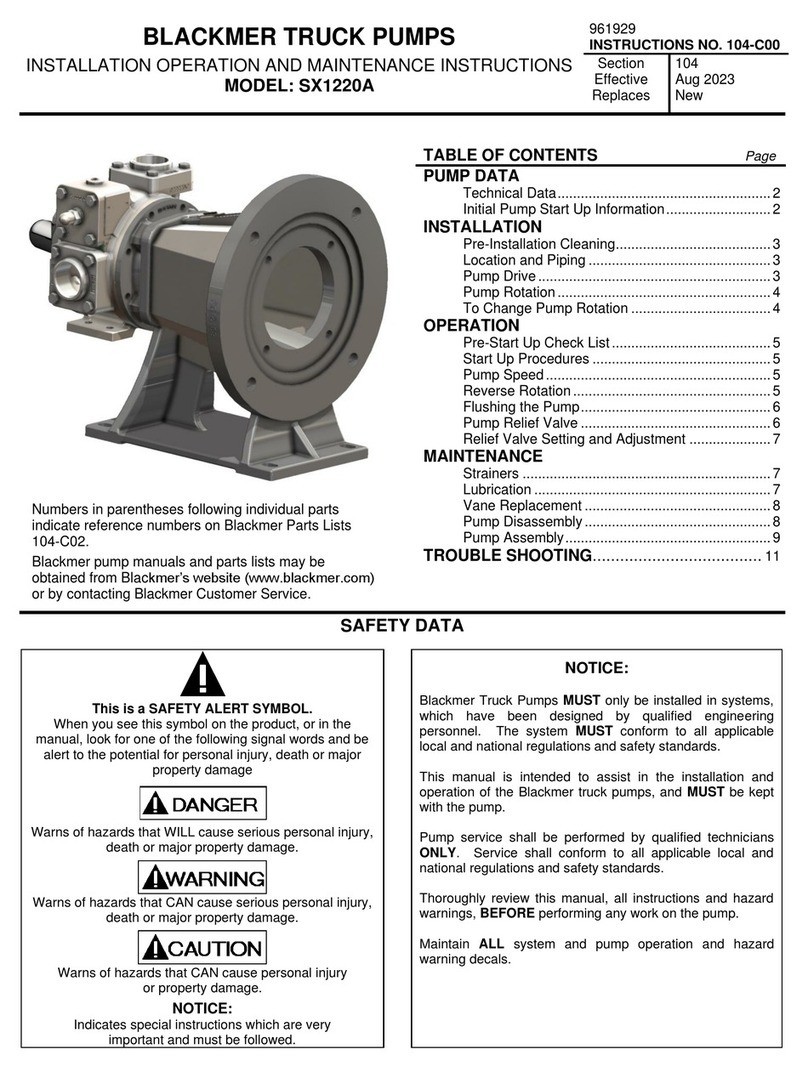
BLACKMER
BLACKMER SX1220A Installation, operation and maintenance instructions

Edwards
Edwards STP Series instruction manual
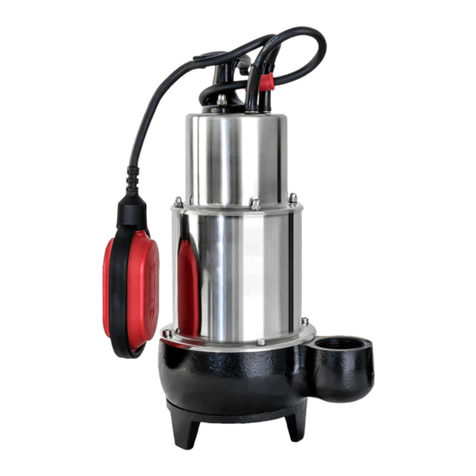
Reefe
Reefe RCE160 Exploded View & Instruction Manual

FläktGroup
FläktGroup Semco NEUTON owner's manual

SPX
SPX Johnson Pump Viking Power 16 instruction manual

